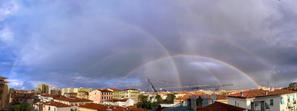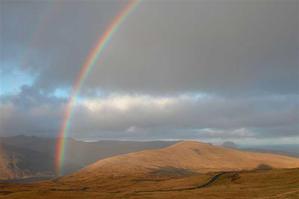Glossary term: Rainbow
Description: The huge arc or bow with concentric stripes in the colors violet, indigo, blue, green, yellow, orange, and red, spread out across the sky, usually visible after it has rained, is called a rainbow. When an observer sees a rainbow, the Sun is at the observer's back. A rainbow occurs because the small droplets of water in the air break up the white sunlight into the color spectrum through a process called dispersion due to refraction; this is similar to how a prism works. In a normal rainbow, light is reflected once within the water droplets as well as being dispersed through refraction.
Sometimes, two nested rainbows can be seen, where the colors in the second rainbow are in reverse order. The inner, brighter one is called the primary rainbow while the outer, fainter one is the secondary rainbow. This double rainbow phenomenon is relatively uncommon. The secondary rainbow occurs when light undergoes reflection twice within the water droplets in addition to refraction.
Related Terms:
See this term in other languages
Term and definition status: This term and its definition have been approved by a research astronomer and a teacher
The OAE Multilingual Glossary is a project of the IAU Office of Astronomy for Education (OAE) in collaboration with the IAU Office of Astronomy Outreach (OAO). The terms and definitions were chosen, written and reviewed by a collective effort from the OAE, the OAE Centers and Nodes, the OAE National Astronomy Education Coordinators (NAECs) and other volunteers. You can find a full list of credits here. All glossary terms and their definitions are released under a Creative Commons CC BY-4.0 license and should be credited to "IAU OAE".
Related Media
24 Hours of Rainbow
Credit: Fabrizio Guasconi/IAU OAE (CC BY 4.0)
License: CC-BY-4.0 Creative Commons Attribution 4.0 International (CC BY 4.0) icons
Related Activities
Reading the Rainbow
astroEDU educational activity (links to astroEDU website) Description: By understanding how rainbows work, you can discover about light and its properties, learning about stars, nebulae, galaxies, and our Universe.License: CC-BY-4.0 Creative Commons Attribution 4.0 International (CC BY 4.0) icons
Age Ranges: 14-16 , 16-19 , 19+ Education Level: Informal , Middle School , Secondary , University Areas of Learning: Interactive Lecture , Observation based , Social Research Costs: Low Cost Duration: 1 hour 30 mins Group Size: Group Skills: Analysing and interpreting data , Asking questions , Engaging in argument from evidence









